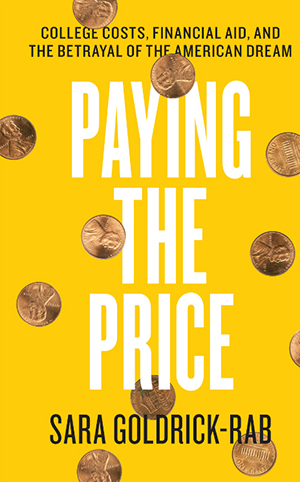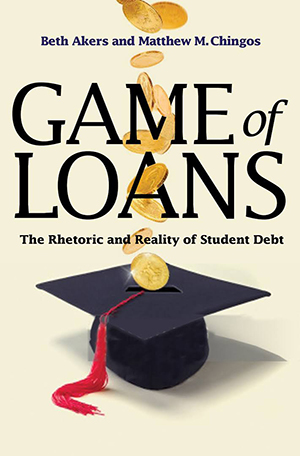Paying the Price: College Costs, Financial Aid, and the Betrayal of the American Dream
by Sara Goldrick-Rab
University of Chicago Press, 2016,
$27.50; 368 pages.
Game of Loans: The Rhetoric and Reality of Student Debt
by Beth Akers and
Matthew M. Chingos
Princeton University Press, 2016,
$26.95; 192 pages.
As reviewed by Jason Delisle
 Two new books offer opposing views on college affordability and the student debt crisis. In Paying the Price, Temple University sociologist Sara Goldrick-Rab concludes that “the lesson from today’s student debt crisis … is that college is unaffordable.” Beth Akers and Matthew Chingos disagree, contending that there is no student loan crisis. The two D.C. researchers pore over the data and find, in Game of Loans, that college prices and student debt loads are more affordable than the dominant political narrative would have us believe.
Two new books offer opposing views on college affordability and the student debt crisis. In Paying the Price, Temple University sociologist Sara Goldrick-Rab concludes that “the lesson from today’s student debt crisis … is that college is unaffordable.” Beth Akers and Matthew Chingos disagree, contending that there is no student loan crisis. The two D.C. researchers pore over the data and find, in Game of Loans, that college prices and student debt loads are more affordable than the dominant political narrative would have us believe.
Some readers might be tempted to read only one of these books—whichever one aligns with their prior beliefs. But those who read both volumes will be rewarded. Game of Loans and Paying the Price take different approaches to their subjects. In the former, the authors use high-level statistics and careful logic to defuse the rhetoric surrounding student debt; in the latter, the author argues that the rhetoric is justified as she documents students’ personal struggles to pay for college. Despite the contrasting styles and perspectives, there’s some common ground between the two that could inform future financial-aid reform.
* * *
Years ago, Goldrick-Rab seized on a unique research opportunity when a philanthropic foundation offered to supplement the financial aid of thousands of lower-income college students in Wisconsin. She conducted extensive interviews with these students to learn about their experiences paying for and attending college. Goldrick-Rab uses their stories to argue that financial aid falls far short of what students need and recommends that lawmakers spend at least $70 to $100 billion more per year to fully cover tuition at public colleges. In her view, that is probably just a start, because the inadequate funding of other social programs—Medicaid, childcare support, food stamps, housing assistance—compounds the college affordability problem for low-income families.
“Inadequate funding” telegraphs Goldrick-Rab’s main message. But in highlighting the inflexibility and unpredictability of student aid programs, she hints at a solution less ambitious and less controversial than $100 billion in additional spending. The lack of sufficient financial aid may be one reason students drop out, but how the available aid is rationed—a little at a time, based on complicated rules, and fluctuating from one semester to the next—is also to blame. Goldrick-Rab does not explicitly say it, but her book shows that if grant and loan programs were more flexible and the rules simpler, more students might complete their degrees and see a greater return on their investments.
Consider Chloe, an under-prepared student in Paying the Price who wants to lighten her course load to focus on improving her grades so she doesn’t become ineligible for student aid. Chloe learns, however, that taking fewer courses reduces the grants that help cover her living expenses, meaning she’d have to work longer hours to make up for the lost funds and never gain additional study time. Worse still, the additional classes available that semester don’t count toward her degree requirements. Imagine if Chloe instead had a student-aid account with a set balance that she could draw upon as needed. Such a system would add simplicity, predictability, and flexibility in one fell swoop. Chloe’s odds of success would certainly improve. And she wouldn’t have to take superfluous courses just to qualify for the aid she needs.
 Reading Game of Loans might prompt readers to consider another solution for the students in Paying the Price. Like Chloe, many students have no choice but to work long hours to pay for school, which prevents them from fully engaging in their studies and probably contributes to the high dropout rate among low-income students. What if these students were allowed and even encouraged to borrow more upfront, so that they could make fewer sacrifices, such as working those long hours, attending school part-time, or scrimping on basic necessities? Would more low-income students complete their degrees? Akers and Chingos illustrate that borrowing more money is far from a catastrophe; in fact, it’s correlated with higher incomes after graduation. The authors acknowledge that students are borrowing more than ever before—average education debt grew by $23,000 between 1992 and 2013, adjusted for inflation—but they argue that a college education is a wise investment. Such an increase in debt, they note, “can be paid off with just a few years of the additional wage income ($7,000) that the average household is collecting each year” relative to 1992. Furthermore, the monthly student-loan burden relative to income has not increased for the typical borrower over the past 20 years.
Reading Game of Loans might prompt readers to consider another solution for the students in Paying the Price. Like Chloe, many students have no choice but to work long hours to pay for school, which prevents them from fully engaging in their studies and probably contributes to the high dropout rate among low-income students. What if these students were allowed and even encouraged to borrow more upfront, so that they could make fewer sacrifices, such as working those long hours, attending school part-time, or scrimping on basic necessities? Would more low-income students complete their degrees? Akers and Chingos illustrate that borrowing more money is far from a catastrophe; in fact, it’s correlated with higher incomes after graduation. The authors acknowledge that students are borrowing more than ever before—average education debt grew by $23,000 between 1992 and 2013, adjusted for inflation—but they argue that a college education is a wise investment. Such an increase in debt, they note, “can be paid off with just a few years of the additional wage income ($7,000) that the average household is collecting each year” relative to 1992. Furthermore, the monthly student-loan burden relative to income has not increased for the typical borrower over the past 20 years.
In contrast, Goldrick-Rab engages in dubious financial reasoning when gauging the affordability of college loans. Using the example of a $16,500 loan for a student whose parents earn less than $30,000, she concludes, “if the family stopped all other spending … it would still take all their income for more than six months to repay the loan.”
By that logic, nearly every home mortgage is unaffordable. Akers and Chingos cut through this faulty reasoning with simple explanations of how student loans can be affordable—and worth it—even if it doesn’t look that way based on half a year’s income.
Akers and Chingos recognize that not all spending on college pays off, and they hold students responsible for making bad investments. But they add that the federal government enables such bad investments by making “no-questions-asked” loans. Meanwhile, the government provides too little information about the likely payoff from attending a particular school—information it collects through agencies such as the Social Security Administration.
The two authors recommend an automatic repayment program for federal loans under which payments would be based on a percentage of the individual’s monthly income. The program would be universal, and payments would be collected through the federal income-tax system. With payments pegged to income from day one, “borrowers would be unable to default on their loans,” they write. Limits on the amount students could borrow and a sufficiently long repayment horizon would prevent gaming of the system and overly generous benefits.
This idea has been around for decades and is plagued with design problems that Akers and Chingos ignore. The income tax system works off household income, and disentangling one member’s income from another’s loan payments is messy. And our tax system matches payments to earners annually, making it a poor fit for tracking interest that accrues daily and loan payments that are owed monthly. A withholding system would also require the government to notify every employer of each employee who has a student loan; otherwise, borrowers would have to elect to have loan payments withheld from their paychecks, undermining the “automatic” promise and reopening the door to default.
Further, such a repayment system might not be well suited for those whose college education doesn’t pay off. According to economic dictum, bad debt should be written off quickly lest it drag down growth. Yet Akers and Chingos do not support loan forgiveness, so they would have borrowers with bad investments repay loans for what might be decades. Why not propose a way to clear bad debts faster?
Both Game of Loans and Paying the Price will fuel the debate about college affordability and student debt. But they offer more than that. Paying the Price is a crash course on how the amalgam of financial aid programs and rules fit together (or don’t), told through the experiences of real people. Game of Loans includes a clear and concise analysis of college prices and student borrowing patterns over time, filling in holes in a debate often bereft of relevant and reliable data.
Jason Delisle is a resident fellow at the American Enterprise Institute (AEI).
This article appeared in the Spring 2017 issue of Education Next. Suggested citation format:
Delisle, J. (2017). Opposing Perspectives on Student Debt: Is the college loan crisis reality or myth? Education Next, 17(2), 91-92.


